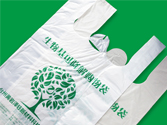The national two departments jointly issued the new standards, biodegradable plastic is stressed again!
The general administration of quality supervision, inspection and quarantine (aqsiq) and the national standards committee (NSC) have recently issued a revised series of national standards for express packaging products.
In terms of promoting green and sustainable development, the newly revised national standards for express packaging products have been supplemented and improved in accordance with the requirements of reduction, greening and recycling. New standards to reduce the Courier envelope paper, air cushion film class class express Courier bags, plastic woven cloth bags quantitative requirements, reduced the thickness of the plastic film class Courier bags, to express the choice of single and double corrugated packing material no longer make a regulation, modulus of the basis of defining the express package size is 600 mm * 400 mm, as long as the material conforms to burst, side pressure and puncture strength index. Require Courier package should be biodegradable plastic to reduce white pollution. Increased the heavy metal and the special material limit request, supplemented and perfected the reuse request and the printing request and so on.
The formulation and implementation of the new standards will play an important role in promoting the use of environment-friendly packaging products with low pollution, low consumption, low emission, high efficiency, high efficiency and high efficiency, and promoting the healthy development of the express delivery industry.
It is understood that there is not much related to green environmental protection in the national standard of express package products released in 2009. According to the requirements of reduction of express package, greening and recycling, the newly revised standard has supplemented and improved relevant contents of the original standard.
Domestic express business maintains a rapid and steady development, which is amazing, and the problems behind it are quite serious. According to statistics from the state post bureau, business volume of express delivery service enterprises continued to rise in 2013, with the growth rate remaining at 25%.
In 2016, China's express delivery business exceeded 31.2 billion pieces for the first time, equivalent to nearly 23 pieces of express delivery per person per year. According to a report on the development status and trends of green packaging in China's express delivery sector issued by the state post bureau, China's express delivery industry consumed about 8.6 billion boxes in 2016, of which about 3.7 billion boxes were directly used by express delivery enterprises, with the rest being self-packed by e-commerce platforms and sellers. The total amount of plastic bags used is about 14.7 billion, among which about 6.8 billion are directly used by express delivery enterprises, and the rest are made by e-commerce platforms and sellers themselves. About 3.2 billion woven bags were used. Total envelope usage: about 3.4 billion; 330 million rolls of tape.
The prosperity of e-commerce has brought about the prosperity of express delivery and logistics, and the prosperity of logistics has brought about the increase of packaging materials and garbage. Those abandoned packaging bags, especially where plastic waste flows, few people. The packaging waste is eating away at healthy land and the environment at a rate of more than 45 percent.
On January 13, 2018, the state post bureau announced the operation situation of the postal industry in 2017. According to the report, the total business volume of national express delivery service enterprises completed 400.6 billion pieces in 2017, and the business volume of Beijing express delivery service was 2.27 billion pieces, ranking the third, only second to jiangsu 3.6 billion pieces and Shanghai 3.12 billion pieces. Meanwhile, the concentration index CR8 of the express and parcel service index was 78.7, basically unchanged from January to November. Some analysts believe that with the continuous increase in the number of express deliveries in China, parcel delivery has entered the era of "100 million packages per day". It is particularly important for express enterprises to maintain the balance between business volume and service satisfaction.
Although we have repeatedly emphasized green packaging and simple packaging in recent years, as the number of business increases, it will be difficult to reduce the waste of packing boxes, plastic bags, etc., and we will continue to share with you after more data are released.
The greenest and greenest materials are coming! Biomaterials refer to the biomass synthetic materials, biomaterials and basic chemical raw materials obtained from renewable resources (such as crops, wastes, trees, other plants and their residues and inclusions, etc.) through the process of biosynthesis, biological processing and biological refining. Generally speaking, biomaterials can be understood as a kind of natural materials obtained by biochemical methods. Most of such materials are biodegradable. From source to processing, and then to material use, recycling and degradation, it is expected to realize the whole green cycle, and it is a kind of important material for future low-carbon economic development.
Mentioned in "twelfth five-year" special planning to significantly enhance the biological base material industry original innovation ability, the breakthrough of a batch of bio-based chemicals and biological materials in the process of biological and chemical conversion, common key technologies, a group of efficient dedicated biosynthesis of microbes, to create a number of biological base of new materials and chemicals, performance at or near base of oil products ~ ~ ~







